Comprehensive Analysis of Business Operations: Tesco Case Study
VerifiedAdded on 2020/11/12
|9
|1750
|133
Report
AI Summary
This report provides a detailed overview of business operations, examining both private and public sectors, with Tesco as a case study. It covers essential aspects such as the importance of accounting for financial planning, record-keeping, and decision-making, as well as the functions of the HR department, including recruitment, compensation, and employee relations. The report also delves into employment legislation features, profit and loss accounts, team leadership, team development stages, and motivation theories. Furthermore, it explores various leadership styles and the impact of customer service. The report concludes with a summary of the key findings and references to the sources used.
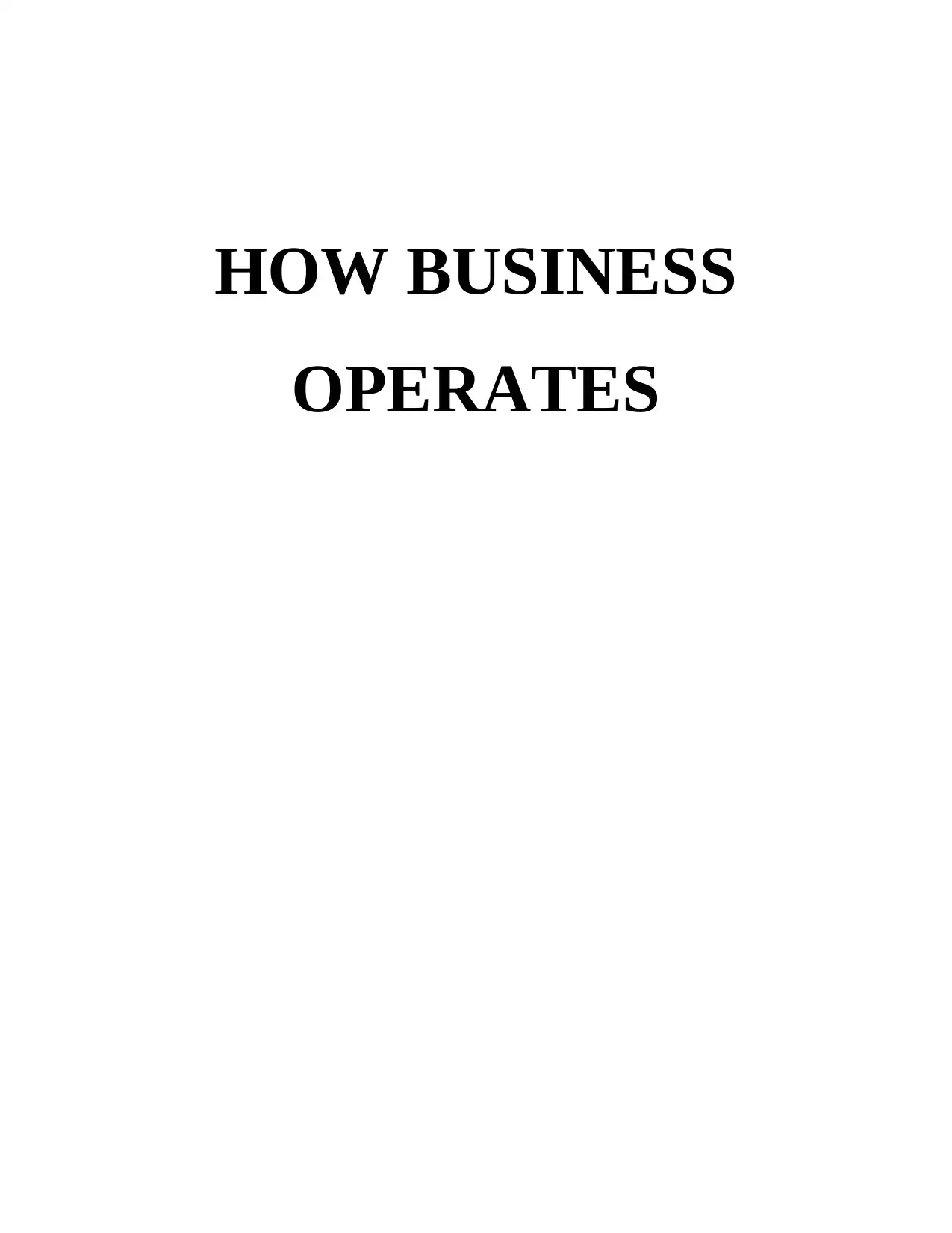
HOW BUSINESS
OPERATES
OPERATES
Paraphrase This Document
Need a fresh take? Get an instant paraphrase of this document with our AI Paraphraser
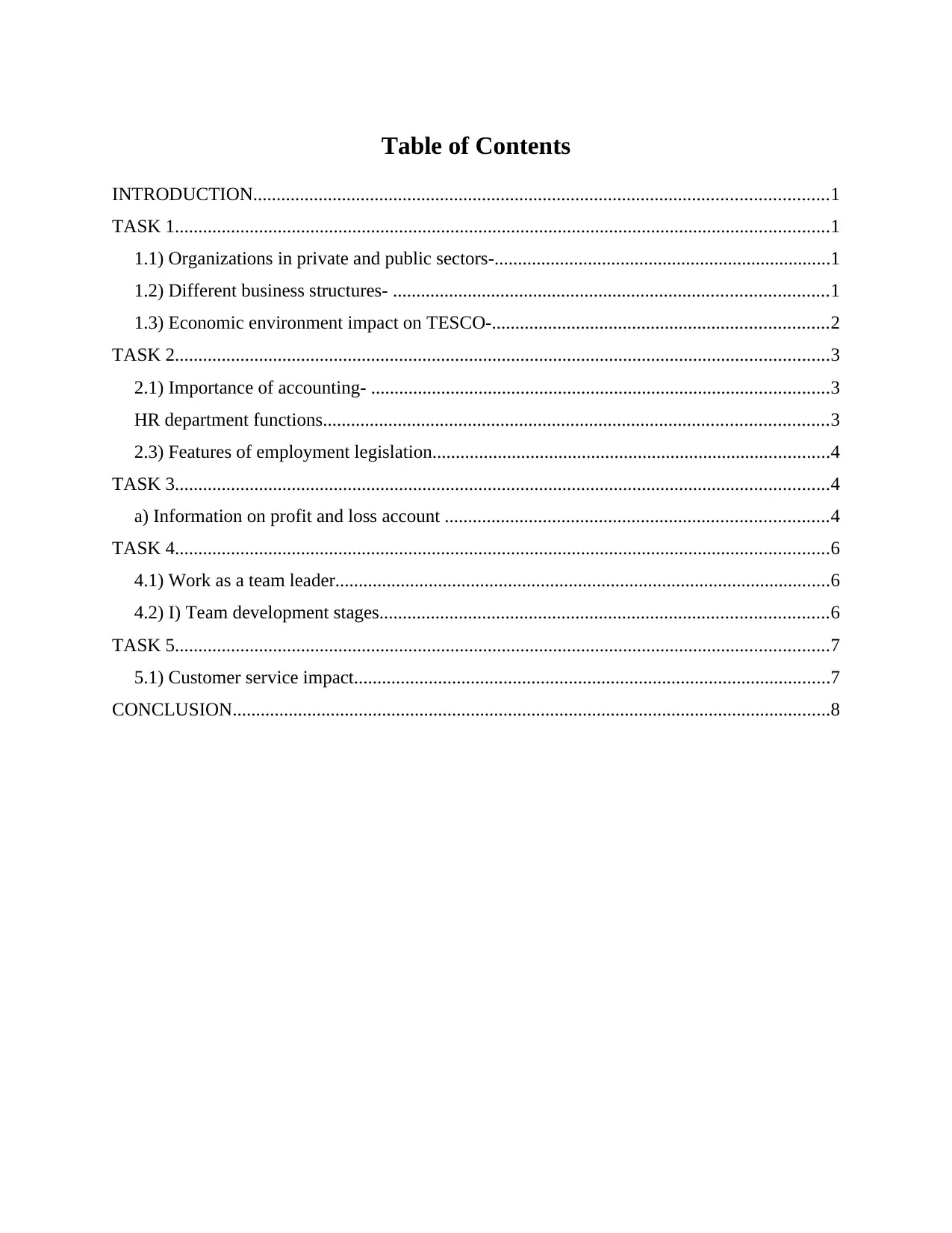
Table of Contents
INTRODUCTION...........................................................................................................................1
TASK 1............................................................................................................................................1
1.1) Organizations in private and public sectors-........................................................................1
1.2) Different business structures- .............................................................................................1
1.3) Economic environment impact on TESCO-........................................................................2
TASK 2............................................................................................................................................3
2.1) Importance of accounting- ..................................................................................................3
HR department functions............................................................................................................3
2.3) Features of employment legislation.....................................................................................4
TASK 3............................................................................................................................................4
a) Information on profit and loss account ..................................................................................4
TASK 4............................................................................................................................................6
4.1) Work as a team leader..........................................................................................................6
4.2) I) Team development stages................................................................................................6
TASK 5............................................................................................................................................7
5.1) Customer service impact......................................................................................................7
CONCLUSION................................................................................................................................8
INTRODUCTION...........................................................................................................................1
TASK 1............................................................................................................................................1
1.1) Organizations in private and public sectors-........................................................................1
1.2) Different business structures- .............................................................................................1
1.3) Economic environment impact on TESCO-........................................................................2
TASK 2............................................................................................................................................3
2.1) Importance of accounting- ..................................................................................................3
HR department functions............................................................................................................3
2.3) Features of employment legislation.....................................................................................4
TASK 3............................................................................................................................................4
a) Information on profit and loss account ..................................................................................4
TASK 4............................................................................................................................................6
4.1) Work as a team leader..........................................................................................................6
4.2) I) Team development stages................................................................................................6
TASK 5............................................................................................................................................7
5.1) Customer service impact......................................................................................................7
CONCLUSION................................................................................................................................8
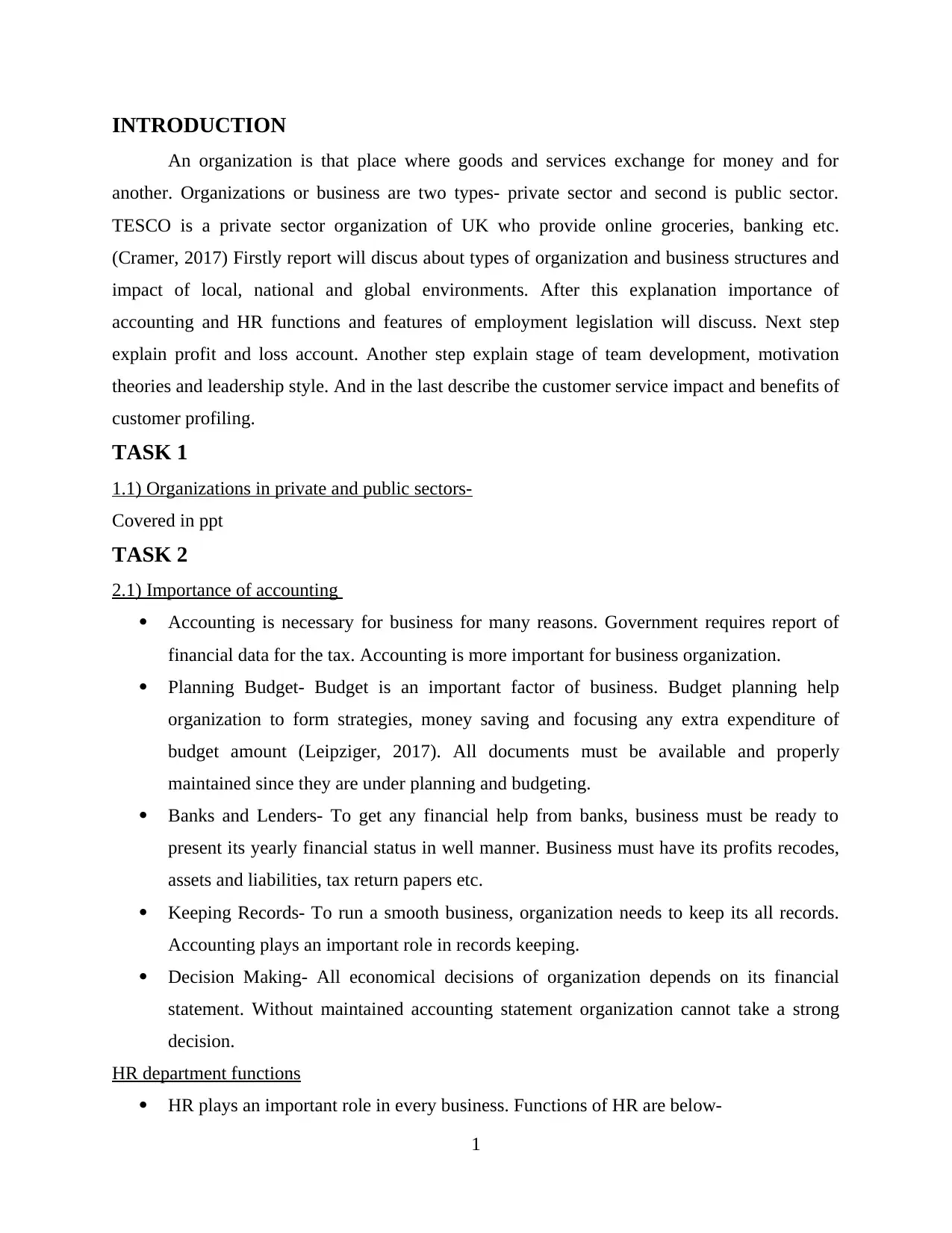
INTRODUCTION
An organization is that place where goods and services exchange for money and for
another. Organizations or business are two types- private sector and second is public sector.
TESCO is a private sector organization of UK who provide online groceries, banking etc.
(Cramer, 2017) Firstly report will discus about types of organization and business structures and
impact of local, national and global environments. After this explanation importance of
accounting and HR functions and features of employment legislation will discuss. Next step
explain profit and loss account. Another step explain stage of team development, motivation
theories and leadership style. And in the last describe the customer service impact and benefits of
customer profiling.
TASK 1
1.1) Organizations in private and public sectors-
Covered in ppt
TASK 2
2.1) Importance of accounting
Accounting is necessary for business for many reasons. Government requires report of
financial data for the tax. Accounting is more important for business organization.
Planning Budget- Budget is an important factor of business. Budget planning help
organization to form strategies, money saving and focusing any extra expenditure of
budget amount (Leipziger, 2017). All documents must be available and properly
maintained since they are under planning and budgeting.
Banks and Lenders- To get any financial help from banks, business must be ready to
present its yearly financial status in well manner. Business must have its profits recodes,
assets and liabilities, tax return papers etc.
Keeping Records- To run a smooth business, organization needs to keep its all records.
Accounting plays an important role in records keeping.
Decision Making- All economical decisions of organization depends on its financial
statement. Without maintained accounting statement organization cannot take a strong
decision.
HR department functions
HR plays an important role in every business. Functions of HR are below-
1
An organization is that place where goods and services exchange for money and for
another. Organizations or business are two types- private sector and second is public sector.
TESCO is a private sector organization of UK who provide online groceries, banking etc.
(Cramer, 2017) Firstly report will discus about types of organization and business structures and
impact of local, national and global environments. After this explanation importance of
accounting and HR functions and features of employment legislation will discuss. Next step
explain profit and loss account. Another step explain stage of team development, motivation
theories and leadership style. And in the last describe the customer service impact and benefits of
customer profiling.
TASK 1
1.1) Organizations in private and public sectors-
Covered in ppt
TASK 2
2.1) Importance of accounting
Accounting is necessary for business for many reasons. Government requires report of
financial data for the tax. Accounting is more important for business organization.
Planning Budget- Budget is an important factor of business. Budget planning help
organization to form strategies, money saving and focusing any extra expenditure of
budget amount (Leipziger, 2017). All documents must be available and properly
maintained since they are under planning and budgeting.
Banks and Lenders- To get any financial help from banks, business must be ready to
present its yearly financial status in well manner. Business must have its profits recodes,
assets and liabilities, tax return papers etc.
Keeping Records- To run a smooth business, organization needs to keep its all records.
Accounting plays an important role in records keeping.
Decision Making- All economical decisions of organization depends on its financial
statement. Without maintained accounting statement organization cannot take a strong
decision.
HR department functions
HR plays an important role in every business. Functions of HR are below-
1
⊘ This is a preview!⊘
Do you want full access?
Subscribe today to unlock all pages.

Trusted by 1+ million students worldwide
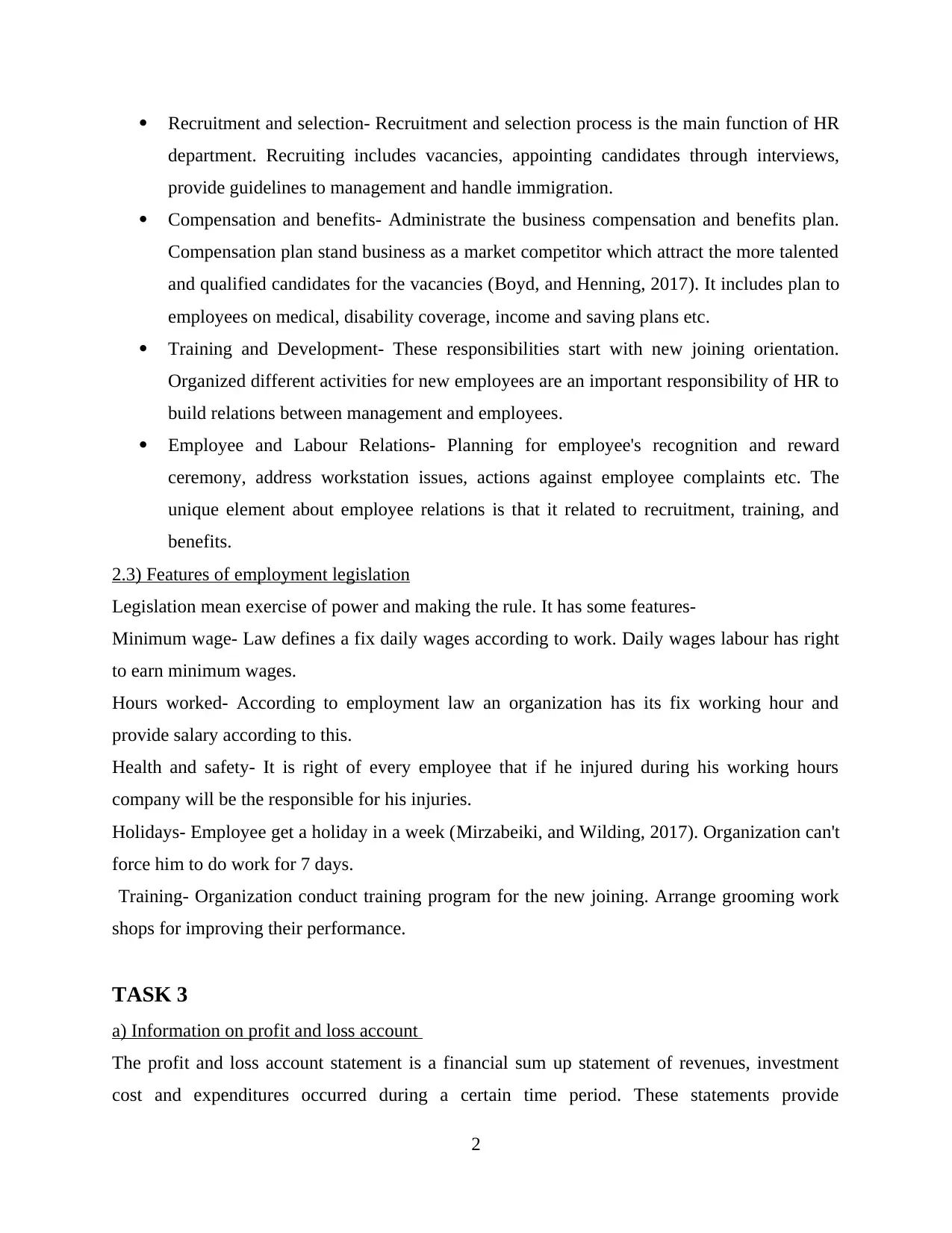
Recruitment and selection- Recruitment and selection process is the main function of HR
department. Recruiting includes vacancies, appointing candidates through interviews,
provide guidelines to management and handle immigration.
Compensation and benefits- Administrate the business compensation and benefits plan.
Compensation plan stand business as a market competitor which attract the more talented
and qualified candidates for the vacancies (Boyd, and Henning, 2017). It includes plan to
employees on medical, disability coverage, income and saving plans etc.
Training and Development- These responsibilities start with new joining orientation.
Organized different activities for new employees are an important responsibility of HR to
build relations between management and employees.
Employee and Labour Relations- Planning for employee's recognition and reward
ceremony, address workstation issues, actions against employee complaints etc. The
unique element about employee relations is that it related to recruitment, training, and
benefits.
2.3) Features of employment legislation
Legislation mean exercise of power and making the rule. It has some features-
Minimum wage- Law defines a fix daily wages according to work. Daily wages labour has right
to earn minimum wages.
Hours worked- According to employment law an organization has its fix working hour and
provide salary according to this.
Health and safety- It is right of every employee that if he injured during his working hours
company will be the responsible for his injuries.
Holidays- Employee get a holiday in a week (Mirzabeiki, and Wilding, 2017). Organization can't
force him to do work for 7 days.
Training- Organization conduct training program for the new joining. Arrange grooming work
shops for improving their performance.
TASK 3
a) Information on profit and loss account
The profit and loss account statement is a financial sum up statement of revenues, investment
cost and expenditures occurred during a certain time period. These statements provide
2
department. Recruiting includes vacancies, appointing candidates through interviews,
provide guidelines to management and handle immigration.
Compensation and benefits- Administrate the business compensation and benefits plan.
Compensation plan stand business as a market competitor which attract the more talented
and qualified candidates for the vacancies (Boyd, and Henning, 2017). It includes plan to
employees on medical, disability coverage, income and saving plans etc.
Training and Development- These responsibilities start with new joining orientation.
Organized different activities for new employees are an important responsibility of HR to
build relations between management and employees.
Employee and Labour Relations- Planning for employee's recognition and reward
ceremony, address workstation issues, actions against employee complaints etc. The
unique element about employee relations is that it related to recruitment, training, and
benefits.
2.3) Features of employment legislation
Legislation mean exercise of power and making the rule. It has some features-
Minimum wage- Law defines a fix daily wages according to work. Daily wages labour has right
to earn minimum wages.
Hours worked- According to employment law an organization has its fix working hour and
provide salary according to this.
Health and safety- It is right of every employee that if he injured during his working hours
company will be the responsible for his injuries.
Holidays- Employee get a holiday in a week (Mirzabeiki, and Wilding, 2017). Organization can't
force him to do work for 7 days.
Training- Organization conduct training program for the new joining. Arrange grooming work
shops for improving their performance.
TASK 3
a) Information on profit and loss account
The profit and loss account statement is a financial sum up statement of revenues, investment
cost and expenditures occurred during a certain time period. These statements provide
2
Paraphrase This Document
Need a fresh take? Get an instant paraphrase of this document with our AI Paraphraser
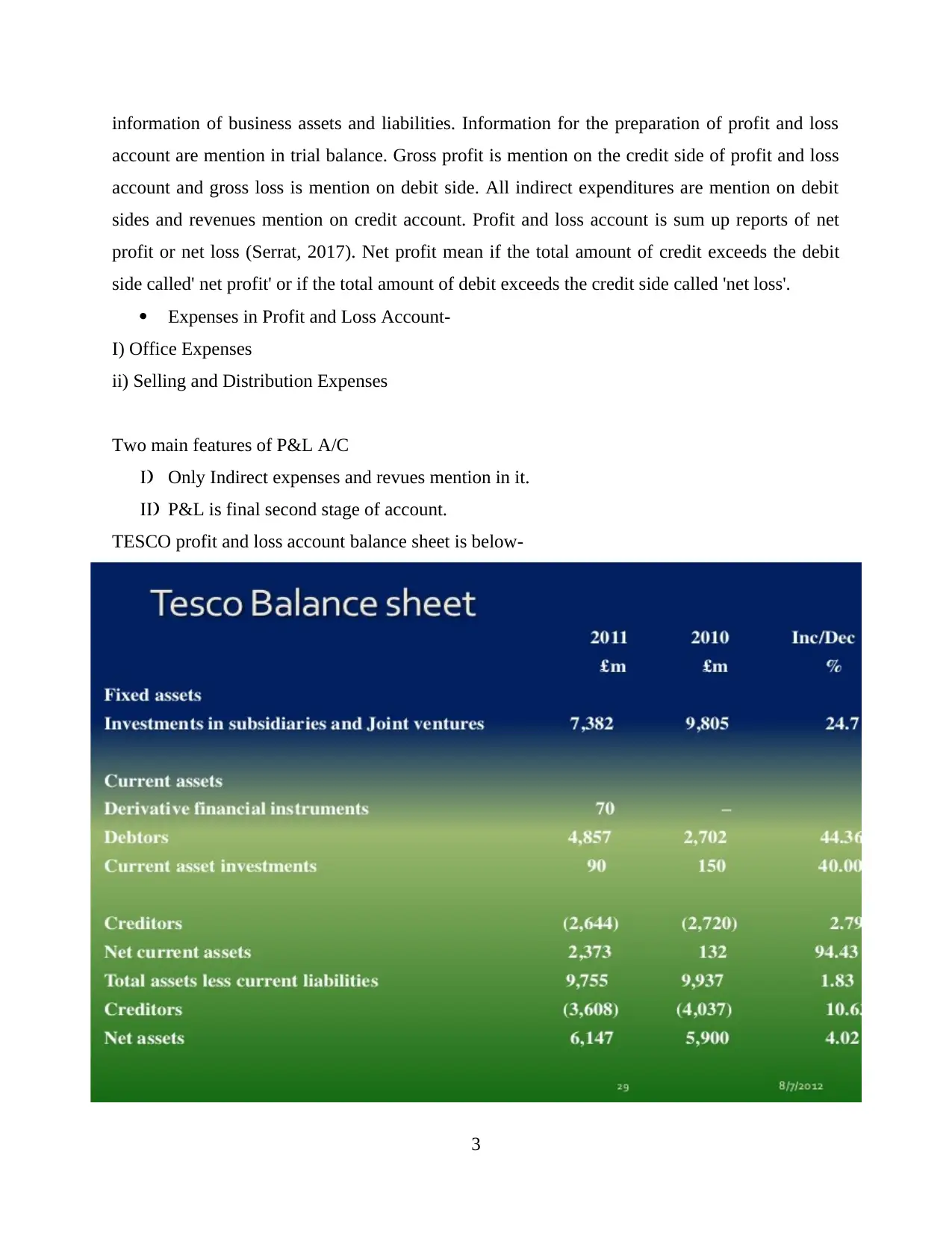
information of business assets and liabilities. Information for the preparation of profit and loss
account are mention in trial balance. Gross profit is mention on the credit side of profit and loss
account and gross loss is mention on debit side. All indirect expenditures are mention on debit
sides and revenues mention on credit account. Profit and loss account is sum up reports of net
profit or net loss (Serrat, 2017). Net profit mean if the total amount of credit exceeds the debit
side called' net profit' or if the total amount of debit exceeds the credit side called 'net loss'.
Expenses in Profit and Loss Account-
I) Office Expenses
ii) Selling and Distribution Expenses
Two main features of P&L A/C
I) Only Indirect expenses and revues mention in it.
II) P&L is final second stage of account.
TESCO profit and loss account balance sheet is below-
3
account are mention in trial balance. Gross profit is mention on the credit side of profit and loss
account and gross loss is mention on debit side. All indirect expenditures are mention on debit
sides and revenues mention on credit account. Profit and loss account is sum up reports of net
profit or net loss (Serrat, 2017). Net profit mean if the total amount of credit exceeds the debit
side called' net profit' or if the total amount of debit exceeds the credit side called 'net loss'.
Expenses in Profit and Loss Account-
I) Office Expenses
ii) Selling and Distribution Expenses
Two main features of P&L A/C
I) Only Indirect expenses and revues mention in it.
II) P&L is final second stage of account.
TESCO profit and loss account balance sheet is below-
3
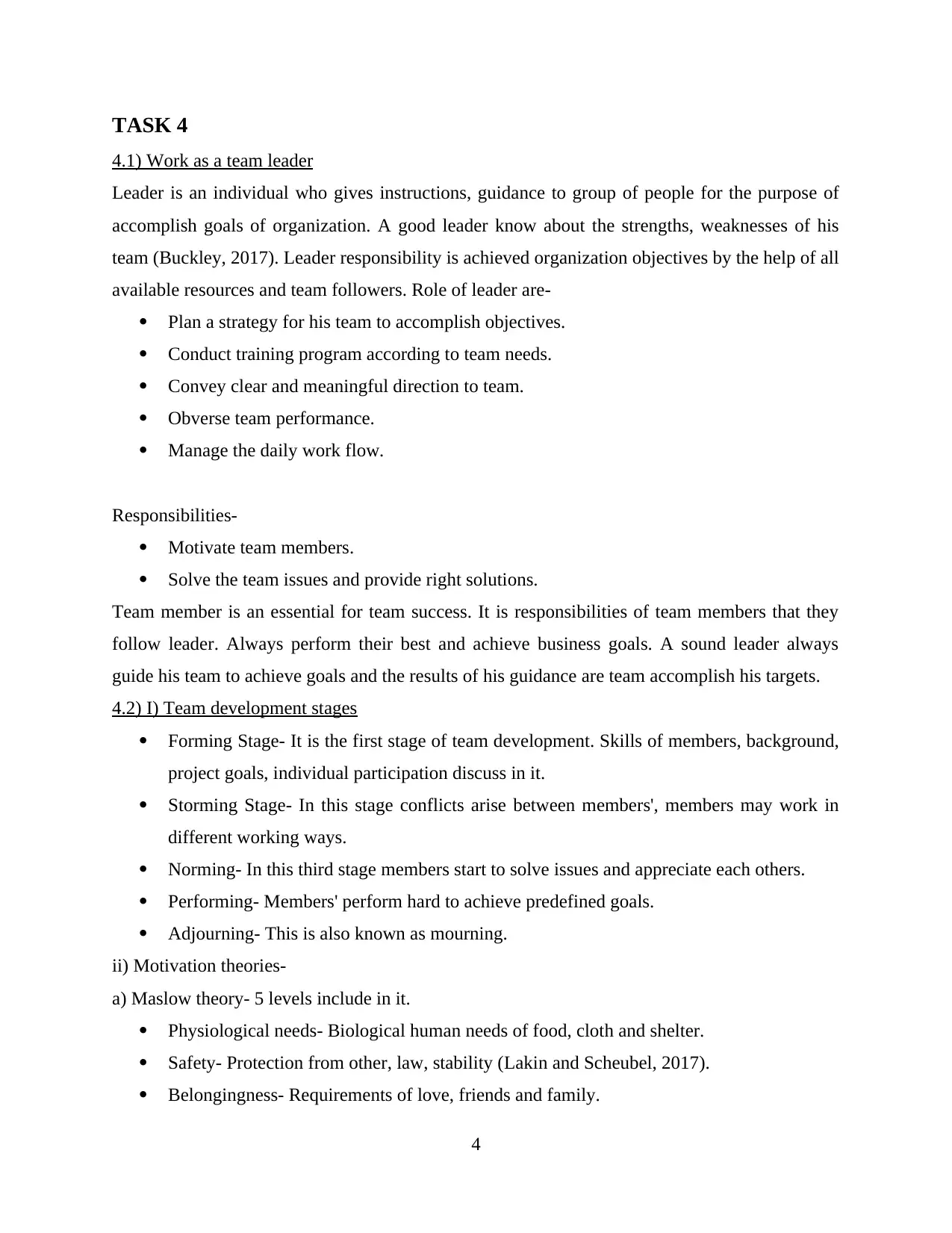
TASK 4
4.1) Work as a team leader
Leader is an individual who gives instructions, guidance to group of people for the purpose of
accomplish goals of organization. A good leader know about the strengths, weaknesses of his
team (Buckley, 2017). Leader responsibility is achieved organization objectives by the help of all
available resources and team followers. Role of leader are-
Plan a strategy for his team to accomplish objectives.
Conduct training program according to team needs.
Convey clear and meaningful direction to team.
Obverse team performance.
Manage the daily work flow.
Responsibilities-
Motivate team members.
Solve the team issues and provide right solutions.
Team member is an essential for team success. It is responsibilities of team members that they
follow leader. Always perform their best and achieve business goals. A sound leader always
guide his team to achieve goals and the results of his guidance are team accomplish his targets.
4.2) I) Team development stages
Forming Stage- It is the first stage of team development. Skills of members, background,
project goals, individual participation discuss in it.
Storming Stage- In this stage conflicts arise between members', members may work in
different working ways.
Norming- In this third stage members start to solve issues and appreciate each others.
Performing- Members' perform hard to achieve predefined goals.
Adjourning- This is also known as mourning.
ii) Motivation theories-
a) Maslow theory- 5 levels include in it.
Physiological needs- Biological human needs of food, cloth and shelter.
Safety- Protection from other, law, stability (Lakin and Scheubel, 2017).
Belongingness- Requirements of love, friends and family.
4
4.1) Work as a team leader
Leader is an individual who gives instructions, guidance to group of people for the purpose of
accomplish goals of organization. A good leader know about the strengths, weaknesses of his
team (Buckley, 2017). Leader responsibility is achieved organization objectives by the help of all
available resources and team followers. Role of leader are-
Plan a strategy for his team to accomplish objectives.
Conduct training program according to team needs.
Convey clear and meaningful direction to team.
Obverse team performance.
Manage the daily work flow.
Responsibilities-
Motivate team members.
Solve the team issues and provide right solutions.
Team member is an essential for team success. It is responsibilities of team members that they
follow leader. Always perform their best and achieve business goals. A sound leader always
guide his team to achieve goals and the results of his guidance are team accomplish his targets.
4.2) I) Team development stages
Forming Stage- It is the first stage of team development. Skills of members, background,
project goals, individual participation discuss in it.
Storming Stage- In this stage conflicts arise between members', members may work in
different working ways.
Norming- In this third stage members start to solve issues and appreciate each others.
Performing- Members' perform hard to achieve predefined goals.
Adjourning- This is also known as mourning.
ii) Motivation theories-
a) Maslow theory- 5 levels include in it.
Physiological needs- Biological human needs of food, cloth and shelter.
Safety- Protection from other, law, stability (Lakin and Scheubel, 2017).
Belongingness- Requirements of love, friends and family.
4
⊘ This is a preview!⊘
Do you want full access?
Subscribe today to unlock all pages.

Trusted by 1+ million students worldwide
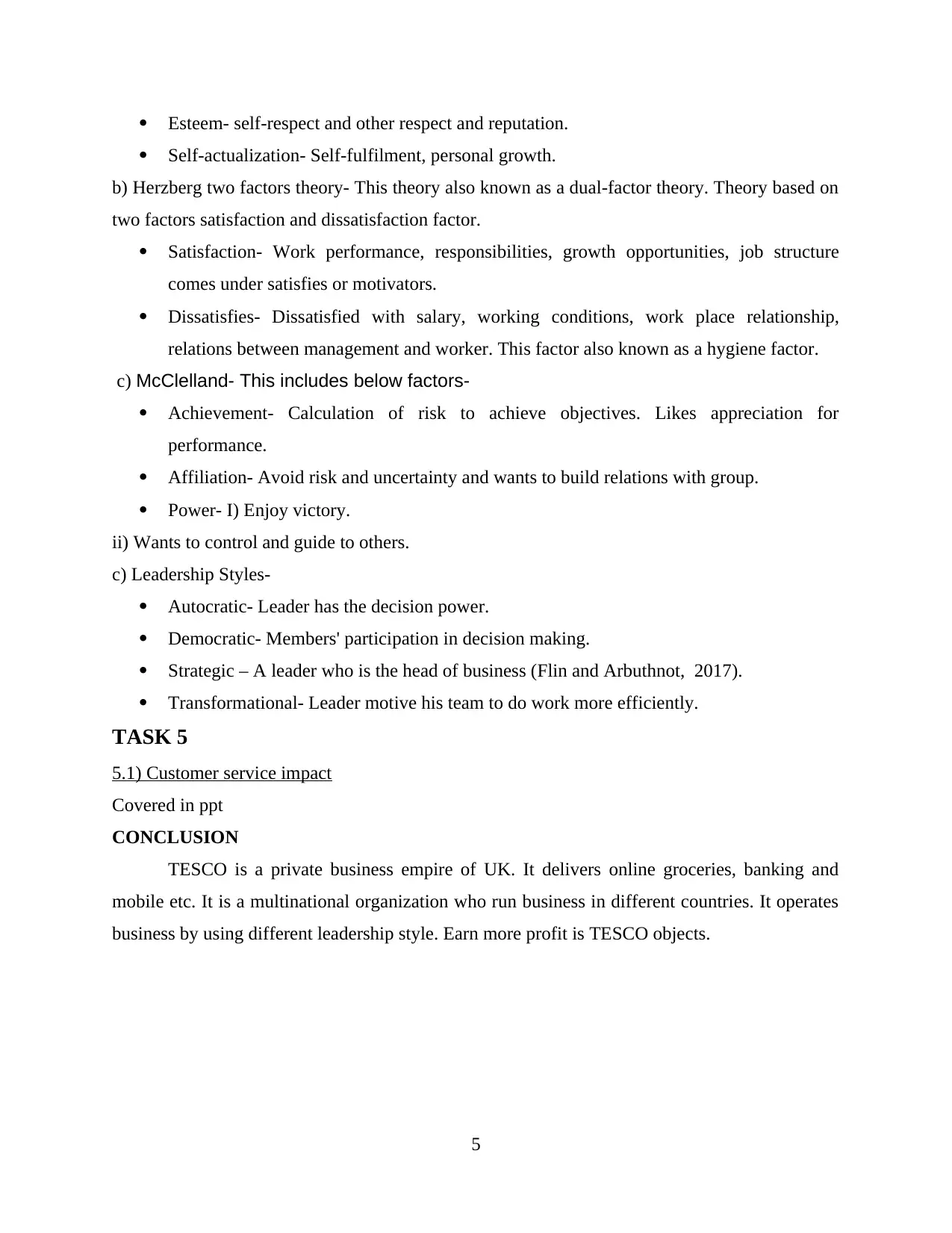
Esteem- self-respect and other respect and reputation.
Self-actualization- Self-fulfilment, personal growth.
b) Herzberg two factors theory- This theory also known as a dual-factor theory. Theory based on
two factors satisfaction and dissatisfaction factor.
Satisfaction- Work performance, responsibilities, growth opportunities, job structure
comes under satisfies or motivators.
Dissatisfies- Dissatisfied with salary, working conditions, work place relationship,
relations between management and worker. This factor also known as a hygiene factor.
c) McClelland- This includes below factors-
Achievement- Calculation of risk to achieve objectives. Likes appreciation for
performance.
Affiliation- Avoid risk and uncertainty and wants to build relations with group.
Power- I) Enjoy victory.
ii) Wants to control and guide to others.
c) Leadership Styles-
Autocratic- Leader has the decision power.
Democratic- Members' participation in decision making.
Strategic – A leader who is the head of business (Flin and Arbuthnot, 2017).
Transformational- Leader motive his team to do work more efficiently.
TASK 5
5.1) Customer service impact
Covered in ppt
CONCLUSION
TESCO is a private business empire of UK. It delivers online groceries, banking and
mobile etc. It is a multinational organization who run business in different countries. It operates
business by using different leadership style. Earn more profit is TESCO objects.
5
Self-actualization- Self-fulfilment, personal growth.
b) Herzberg two factors theory- This theory also known as a dual-factor theory. Theory based on
two factors satisfaction and dissatisfaction factor.
Satisfaction- Work performance, responsibilities, growth opportunities, job structure
comes under satisfies or motivators.
Dissatisfies- Dissatisfied with salary, working conditions, work place relationship,
relations between management and worker. This factor also known as a hygiene factor.
c) McClelland- This includes below factors-
Achievement- Calculation of risk to achieve objectives. Likes appreciation for
performance.
Affiliation- Avoid risk and uncertainty and wants to build relations with group.
Power- I) Enjoy victory.
ii) Wants to control and guide to others.
c) Leadership Styles-
Autocratic- Leader has the decision power.
Democratic- Members' participation in decision making.
Strategic – A leader who is the head of business (Flin and Arbuthnot, 2017).
Transformational- Leader motive his team to do work more efficiently.
TASK 5
5.1) Customer service impact
Covered in ppt
CONCLUSION
TESCO is a private business empire of UK. It delivers online groceries, banking and
mobile etc. It is a multinational organization who run business in different countries. It operates
business by using different leadership style. Earn more profit is TESCO objects.
5
Paraphrase This Document
Need a fresh take? Get an instant paraphrase of this document with our AI Paraphraser

6
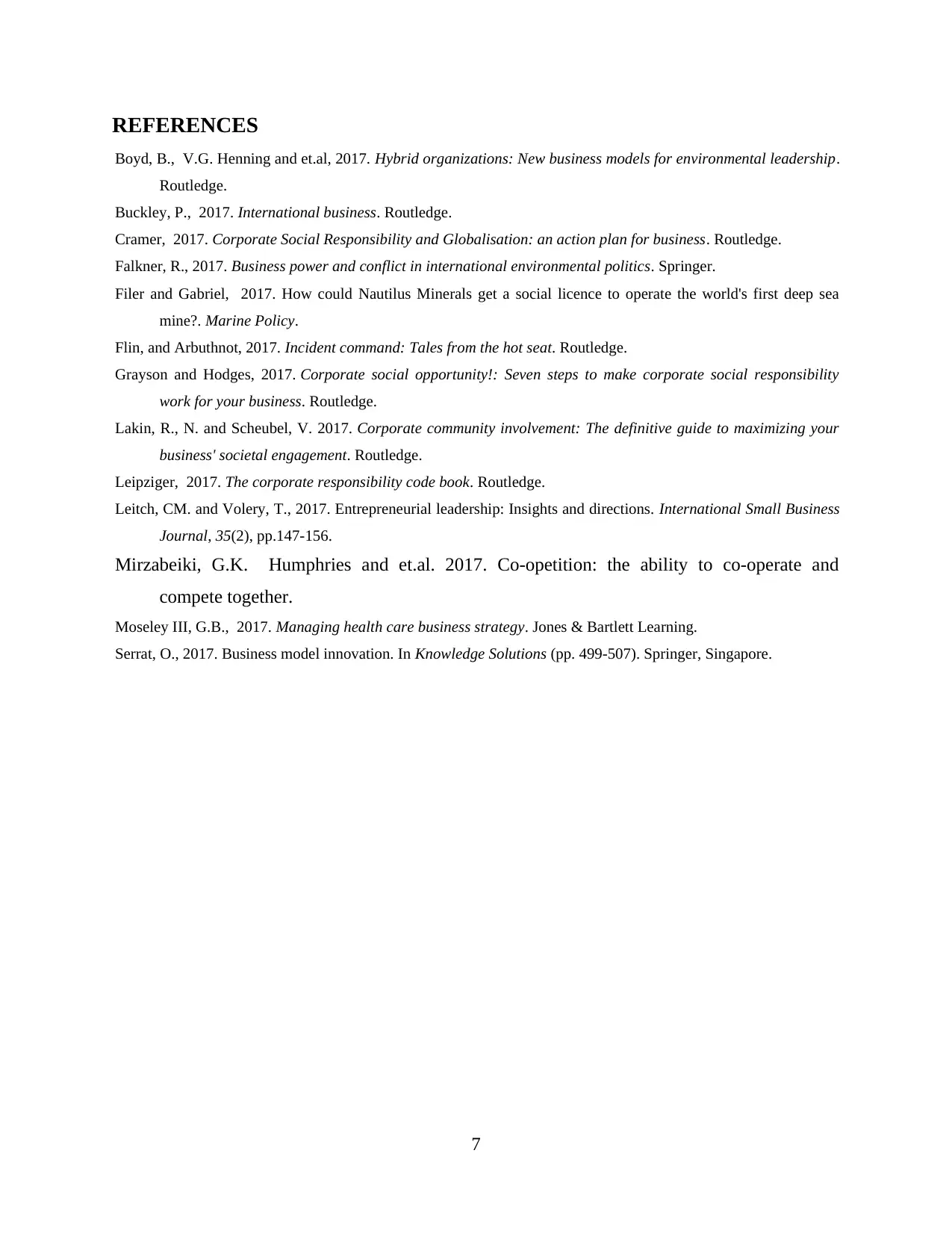
REFERENCES
Boyd, B., V.G. Henning and et.al, 2017. Hybrid organizations: New business models for environmental leadership.
Routledge.
Buckley, P., 2017. International business. Routledge.
Cramer, 2017. Corporate Social Responsibility and Globalisation: an action plan for business. Routledge.
Falkner, R., 2017. Business power and conflict in international environmental politics. Springer.
Filer and Gabriel, 2017. How could Nautilus Minerals get a social licence to operate the world's first deep sea
mine?. Marine Policy.
Flin, and Arbuthnot, 2017. Incident command: Tales from the hot seat. Routledge.
Grayson and Hodges, 2017. Corporate social opportunity!: Seven steps to make corporate social responsibility
work for your business. Routledge.
Lakin, R., N. and Scheubel, V. 2017. Corporate community involvement: The definitive guide to maximizing your
business' societal engagement. Routledge.
Leipziger, 2017. The corporate responsibility code book. Routledge.
Leitch, CM. and Volery, T., 2017. Entrepreneurial leadership: Insights and directions. International Small Business
Journal, 35(2), pp.147-156.
Mirzabeiki, G.K. Humphries and et.al. 2017. Co-opetition: the ability to co-operate and
compete together.
Moseley III, G.B., 2017. Managing health care business strategy. Jones & Bartlett Learning.
Serrat, O., 2017. Business model innovation. In Knowledge Solutions (pp. 499-507). Springer, Singapore.
7
Boyd, B., V.G. Henning and et.al, 2017. Hybrid organizations: New business models for environmental leadership.
Routledge.
Buckley, P., 2017. International business. Routledge.
Cramer, 2017. Corporate Social Responsibility and Globalisation: an action plan for business. Routledge.
Falkner, R., 2017. Business power and conflict in international environmental politics. Springer.
Filer and Gabriel, 2017. How could Nautilus Minerals get a social licence to operate the world's first deep sea
mine?. Marine Policy.
Flin, and Arbuthnot, 2017. Incident command: Tales from the hot seat. Routledge.
Grayson and Hodges, 2017. Corporate social opportunity!: Seven steps to make corporate social responsibility
work for your business. Routledge.
Lakin, R., N. and Scheubel, V. 2017. Corporate community involvement: The definitive guide to maximizing your
business' societal engagement. Routledge.
Leipziger, 2017. The corporate responsibility code book. Routledge.
Leitch, CM. and Volery, T., 2017. Entrepreneurial leadership: Insights and directions. International Small Business
Journal, 35(2), pp.147-156.
Mirzabeiki, G.K. Humphries and et.al. 2017. Co-opetition: the ability to co-operate and
compete together.
Moseley III, G.B., 2017. Managing health care business strategy. Jones & Bartlett Learning.
Serrat, O., 2017. Business model innovation. In Knowledge Solutions (pp. 499-507). Springer, Singapore.
7
⊘ This is a preview!⊘
Do you want full access?
Subscribe today to unlock all pages.

Trusted by 1+ million students worldwide
1 out of 9
Related Documents
Your All-in-One AI-Powered Toolkit for Academic Success.
+13062052269
info@desklib.com
Available 24*7 on WhatsApp / Email
![[object Object]](/_next/static/media/star-bottom.7253800d.svg)
Unlock your academic potential
Copyright © 2020–2025 A2Z Services. All Rights Reserved. Developed and managed by ZUCOL.





